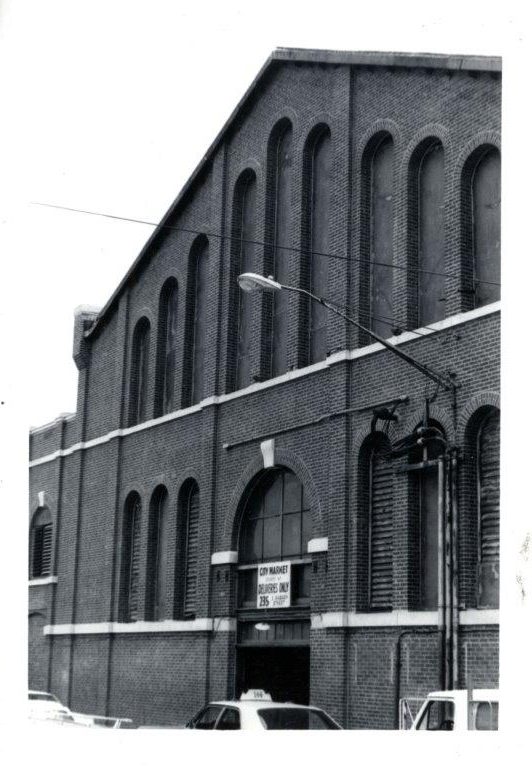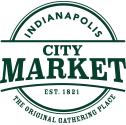Photos of the Indianapolis City Market and Catacombs
City of Indianapolis, Department of Metropolitan Development
Established in 1821, Indianapolis’ City Market has been a vital downtown hub, connecting farmers to urban communities and offering business opportunities. The market flourished as a vibrant social and economic center within Tomlinson Hall since 1885, serving as a pivotal source for produce and food essentials. However, challenges like urbanization and competition from private vendors arose. In 1958, a fire gutted Tomlinson Hall, leaving only an archway in the west plaza and its basement intact. In the aftermath of the fire, the City Market—already facing an uncertain future— found itself in an even more precarious position as Indianapolis city leaders and officials, along with ordinary citizens, began a suddenly more urgent conversation about what to do with this tenacious institution. The fire symbolized a decline in customers and stands, sparking urgent discussions about its fate.
In 1962, plans to extend the new City-County Building’s vision across downtown led to proposals to demolish the remains of Tomlinson Hall, prompting public outcry. In 1964, over 800 residents gathered for a town hall meeting, expressing strong support for preserving the City Market. Legal battles ensued, with supporters advocating through letters, meetings, and patronage. Eventually, agreements were reached to prevent closure. Mayor Richard Lugar’s election and Frank Murray’s appointment as Market Manager revitalized the space. Murray oversaw exterior cleaning, improved lighting, and standardized operations. He enforced employee attendance, rent standards, and cleanliness protocols. The market expanded operating hours, introduced music, and underwent a rebranding effort in 1969 as the “Internationale City Market,” reflecting its diverse stand offerings.
In 1972, Eli Lilly granted nearly $5 million to expand the City Market, recognizing its historical value and strategic location. The project aimed to modernize while preserving heritage, replacing old sheds with modern wings and adding a mezzanine for more stands. Mayor Lugar and his successor Mayor Hudnut shifted preservation focus from transforming historical buildings into public heritage showcases by instead revitalizing the original market. As customer preferences changed, the market adapted, catering more to prepared foods and a lunchtime crowd. In 1985, ownership transferred from the Department of Metropolitan Development (DMD), which struggled with the day-to-day management of the market to a private firm, Cornerstone Incorporated. Included in Cornerstone’s new proposal for the market was the construction of Market Tower, a ten-story office building on the west wing of the market property, for additional revenue. However, the proposal faced opposition from preservationists and community groups under the Coalition to Save Vital Spaces.
In 1989, amid debates over the Market Tower, neglect of City Market management prompted the creation of a non-profit corporation to lease and manage the building. The Indianapolis City Market Corporation took charge, focusing on efficient management and maintenance. By 1994, facing declining foot traffic, they sought to attract new customer demographics and continue its commitment to actively recruit small businesses and avoid national chains. The opening of Circle Center Mall in 1995 and the demolition of Market Square Arena in 2001 intensified competition for the Downtown lunch crowd. Further renovations in 2008, encompassing new flooring, plumbing, electrical upgrades, and restroom renovations, aimed to rejuvenate the space. In 2009, a study proposed a three-year closure for extensive repairs, but Mayor Ballard rejected it, opting for cost reductions and consolidation. Despite the ongoing controversies, the market continued to expand its customer base and in 2011, City Market introduced Tomlinson Tap, a bar featuring Indiana craft beers, on the upper mezzanine.
In 2010, the city invested $3.5 million to revamp the Market wings. The eastern wing became the Indy Bike Hub, housing bike facilities and fitness centers and its proximity to the Indianapolis Cultural Trail made it popular for cyclists. Management enhanced the Market’s appeal with various events, including the Original Farmers’ Market. By 2012, with over 30 vendors, the City Market became a “whole food destination,” bustling with activity and nearly full occupancy.
In recent years, the Market has operated as a beloved historical site and lunch-counter location for residents working Downtown. Tours are offered of the building’s catacombs, where visitors can peer beneath the city at the long-hidden ruins of Tomlinson Hall. The basement of Tomlinson Hall was preserved as well and lies underneath the west wing of the City Market. After the fire, the space was used sparingly for rare special events like fundraising balls, and allegedly as an Indianapolis Police Department firing range.
Like many other small businesses, the City Market has had to adapt to new circumstances, especially amid the Covid-19 pandemic. Vendors worked diligently to shift their focus to offer takeout, delivery, and curbside pick-up options. They continued to serve customers while adhering to local authorities and safety protocols such as social-distancing and limited capacities. The city and the City Market Corporation worked to support the City Market throughout these difficult times by providing financial assistance, guidance on navigating government aid programs, and promoting their businesses online.
Major renovations are needed to sustain the City Market’s legacy. In 2024, the Department of Metropolitan Development, in collaboration with the Indianapolis City Market Corporation announced the planned closure of the City Market starting on March 1, 2024, for redevelopment. Over the last few months, the city has offered support to vendors, having waived their rent in January and February of 2024. However, in order to work towards a sustainable business model for the market, substantial building renovations and reforms to management practices are needed. The renovation is part of the City Market East and West Plaza Redevelopment project, a $200 million endeavor with local developers to convert the Gold Building, construct an 11-story tower, and upgrade pedestrian infrastructure, bringing about 400 housing units and public space upgrades to the area.
https://scholarworks.iupui.edu/items/68e382ca-469c-4e0a-bc2e-24ca9e89bb8c
UiAwJX5QLaZtgai7iOMQ (graphassets.com)
___________________________________________________
About the City of Indianapolis Department of Metropolitan Development
The City of Indianapolis Department of Metropolitan Development (Indy DMD) works to shape the city’s identity by strengthening people and places, building upon our history, and fostering visionary development. The Indy DMD envisions Indianapolis as a growing, vibrant, and beautiful city where people and businesses thrive in an inclusive, world class community.
About the Indianapolis City Market Corporation
The Indianapolis City Market’s history is as rich as the promise of its future. When opened in 1886, the market ushered in a new tradition: an open space for the sale of meats and produce, The Original Gathering Place, if you will. Indianapolis City Market is listed in the National Register of Historic Places and is a vibrant downtown event destination.


